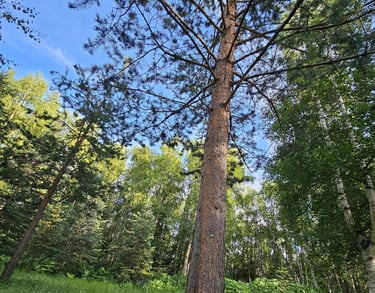Lodgepole Pine
The Lodgepole Pine (Pinus contorta) is a resilient, slender conifer native to western North America, thriving in diverse climates from coastal regions to high mountains. Known for its straight trunk and soft, dark green needles, this evergreen reaches heights of 50-80 feet. Its small, prickly cones often remain closed until opened by fire, aiding forest regeneration. Ideal for rugged landscapes, the Lodgepole Pine is a symbol of adaptability and endurance.



Your Lodgepole
Coming soon...
Care For Me
Step 1: Choose the Right Location
- Select a site with well-drained, sandy, or loamy soil and full sun to partial shade.
- Ensure the area has enough space for the tree to grow (up to 80 feet tall and 20 feet wide).
- Avoid low-lying areas prone to waterlogging.
Step 2: Prepare for Planting
- Timing: Plant in early spring (April-May) after the last frost for best root establishment.
- Obtain a healthy lodgepole pine seedling from a local nursery, ideally 1-2 years old.
- Dig a hole twice as wide and as deep as the root ball.
Step 3: Plant the Seedling
- Place the seedling in the hole, ensuring the root collar is level with the soil surface.
- Backfill with native soil, gently tamping to remove air pockets.
- Water thoroughly to settle the soil.
Step 4: Moose Protection
- Install a sturdy tree guard or fence around the seedling:
- Use a 5-6 foot tall metal or heavy-duty plastic mesh cage, anchored with stakes.
- Ensure the guard extends 6-12 inches below ground to deter digging.
- Alternatively, wrap the trunk with burlap or plastic spiral guards to protect from browsing.
- Check guards regularly for damage and adjust as the tree grows.
Step 5: Watering and Mulching
- Water deeply once a week during the first growing season, especially in dry periods (about 1 inch of water).
- Apply 2-3 inches of organic mulch (e.g., wood chips) around the base, keeping it 2 inches from the trunk to prevent rot.
Step 6: Ongoing Care
- Fertilization: Avoid fertilizing in the first year. In year two, use a balanced slow-release fertilizer (e.g., 10-10-10) in spring if growth is slow.
- Pruning: Remove dead or damaged branches in late winter or early spring. Minimal pruning is needed.
- Monitoring: Check for pests like pine beetles or diseases like rust. Consult a local extension service if issues arise.
Step 7: Winter Protection
- In harsh Alaskan winters, wrap young trees with burlap to shield from windburn and heavy snow.
- Ensure mulch is replenished to insulate roots.
Tips:
- Lodgepole pines are hardy (USDA Zone 4-8) and tolerate Alaska’s cold well.
- Regularly inspect moose protection, especially in fall when moose are more active.
- For specific advice, contact the Alaska Division of Forestry or local cooperative extension.
Just for Fun
Fun Facts About Lodgepole Pine (Pinus contorta)
1. Twisted Namesake: The lodgepole pine gets its name from its historical use by Native Americans and early settlers, who used its straight, slender trunks as poles for lodges, tipis, and other structures.
2. Fire-Adapted Superstar: Many lodgepole pines have serotinous cones that remain sealed until exposed to intense heat, like from a wildfire. The heat melts the resin, releasing seeds to regenerate forests after fires.
3. Alaska’s Tough Survivor: Thriving in Alaska’s harsh climate, lodgepole pines can grow in poor soils and tolerate extreme cold, making them a resilient species in the boreal forest.
4. Ecological MVP: They provide critical habitat for wildlife, including birds like crossbills, which feed on their seeds, and mammals like moose, though the latter can damage young trees.
5. Variety Show: Lodgepole pine has several subspecies, with the "shore pine" (Pinus contorta subsp. contorta) growing as a shorter, twisted tree along Alaska’s coasts, while the inland variety can soar up to 80 feet.
6. Woodsy Versatility: Its wood is used for everything from lumber and plywood to railroad ties and even traditional Native American crafts, thanks to its strength and straight grain.